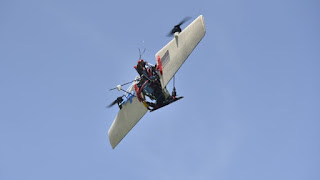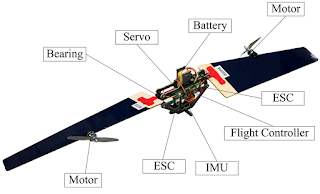We
all know normal multicopter drones are effective at hovering and
Vertical Take-Off and Landing, they can't travel long-distance as
efficiently as aircraft with fixed wings. This has been listed as
their main disadvantage. But not any more. A team of students from
the Singapore University of Technology and Design (SUTD) is trying to
get the best of both worlds with the Transformable HOvering
Rotorcraft (THOR).
According
to the design team, THOR's design inspiration came from the samara
seed, 'helicopter' tree seed that is capable of flying long distances
because of its stable shape. The concept was earlier raised
in 1913 called
the monocopter,
it
was "structurally efficient" ,the whole frame is used to
generate lif, but "strategically inefficient." The lack of
counter-rotational systems meant the pilot and cargo would have
needed to spin with the rest of the aircraft, making it impractical
to actually ride in.
Usually,
when aircraft makers want to hover and cruise, they simply fix rotors
onto rotating wings, but with THOR the wings become
rotors,
transitioning in mid-air and spinning around a central module like a
single-bladed helicopter. THOR manages to achieve very high
structural efficiency by using all of its aerodynamic surfaces in
both
vertical and horizontal flight modes,
transforming from a flying wing into a sort of whole-body spinning
bicopter thing that you really need to see to believe.
How
THOR actually works?? It has two modes of flight: hovering mode
(H-MOD) and cruising or fixed mode(C-MOD).When transitioning from
hover mode to fixed-wing mode, the wings rotate into alignment. When
the drone is in hover mode (left), it can rotate its wings (servos)
by 90 degrees (middle) to transition to cruise mode (right). And when
in cruise mode, it can do the reverse to switch to hover mode. During
this transition, centrifugal force of switch is used to move the
ballast, a weight in an aircraft used to bring the center of gravity
into the allowable range, to keep the aircraft balanced.
Two
key points in the innovative design are First are the bearings placed
between the drone’s body and the wings. The bearings allow the
wings to rotate appropriately depending on what flight mode is used.
Second is the motor power, primarily in hover mode. The motor must
have sufficient power during the transformation so that THOR doesn’t
just fall to the ground. It needs enough power to create the
instantaneous transformation without losing altitude, but not so much
power that the motor will break the wings.
The
UAV business is now getting a world of extremes. At one end, you've
got hobby-grade consumer gear, which has improved dramatically in the
last couple of years, and at the other end, you've got the military
gear tough, rugged. There are no real standards for industrial-grade
drones yet, but it is a continually growing market as all sorts of
companies in all sorts of areas start to discover the power and
potential of unmanned aerial systems. The advantage lies in its
applications as the commercial world can see the benefits of
industrial-grade UAV tools. It'll be interesting to see what sort of
machinery and standards develop in this space over the next few
years.
Applications of THOR seems to be endless i.e. anything that requires both long range and an agile hover, and because of its inherent potential to scale, it can be made smaller than other hybrid platforms,which will unlock many possibilities where current hybrid UAVs are too big or bulky to operate! These include agriculture, surveillance, and package delivery, all of which are hot topics in drone development as of the moment. I really hope this turns out to be a platform for the development of the next-generation unmanned programs.
Applications of THOR seems to be endless i.e. anything that requires both long range and an agile hover, and because of its inherent potential to scale, it can be made smaller than other hybrid platforms,which will unlock many possibilities where current hybrid UAVs are too big or bulky to operate! These include agriculture, surveillance, and package delivery, all of which are hot topics in drone development as of the moment. I really hope this turns out to be a platform for the development of the next-generation unmanned programs.



No comments:
Post a Comment